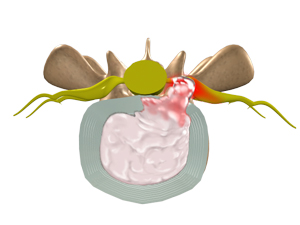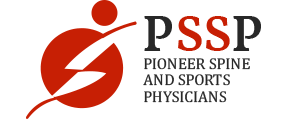Disc Herniation

Disc Anatomy
The intervertebral discs are flat and round, present between vertebrae and act as shock absorbers when you walk or run. There is a soft, gelatinous material in the center (nucleus pulposus) which is encased in strong elastic tissue forming a ring around it called annulus fibrosus.
What is Disc Herniation?
Disc herniation is a condition where the central nucleus pushes through the outer edge of the disk, causing a bulge that potentially compresses the spinal nerves.
Causes of Disc Herniation
Aging, injury or trauma may cause the annulus fibrosus to tear resulting in protrusion of the nucleus pulposus. This may compress the spinal nerves and/or spinal canal. The bulging disc may even break open releasing the gelatinous material, which is a chemical irritant, causing inflammation of the spinal nerves.
Obesity, sedentary lifestyle and smoking increase the risk of lumbar disc herniation.
Symptoms of Disc Herniation
The symptoms of lumbar disc herniation include:
- Mild to intense back pain, making it difficult to bend
- Numbness and weakness in the leg or foot leading to the sensation of tingling (pins and needles)
- Leg and/or feet pain making it difficult to walk or stand
- In rare cases, loss of bowel and bladder function (cauda equine syndrome) may occur. This condition requires immediate medical attention.
Diagnosis of Disc Herniation
Diagnosis includes medical history coupled with a physical and neurological examination. Neurological examination is done to indicate any neurological injury and involves evaluation of reflexes and muscle weakness by various tests. To confirm the diagnosis, the doctor may order an MRI to evaluate changes in the disc and spinal nerves.
Treatment of Disc Herniation
Non-surgical treatment of Disc Herniation
Non-surgical treatment is preferred over surgery and includes rest, activity modification, and medication which may include non-steroidal anti-inflammatory drugs, muscle relaxants or other agents and epidural analgesic injections. Back braces may be recommended to keep the lower back still and reduce mechanical pain due to movement. Physical therapy may be helpful in some cases.Spinal injections may be helpful to reduce nerve irritation.
Surgery of Disc Herniation
Surgery is considered in cases with significant leg pain, muscle weakness and numbness that is unresolved after conservative treatment measures. Urgent surgery may be required if neurologic dysfunction or cauda equine syndrome occurs or in the case of worsening neurologic impairment.
Related Links
- Neck Pain
- Whiplash
- Back Pain
- Lumbar Radiculopathy
- Degenerative Disc Disease
- Disc Herniation
- Facet joint Arthritis
- Sciatica
- Spondylolysis
- Spondylolisthesis
- Vertebral Compression Fractures
- Scoliosis
- Kyphosis
- Cervical Disc Herniation
- Lumbar Disc Herniation
- Cervical Radiculopathy/Myelopathy
- Cervical Stenosis
- Lumbar Stenosis
